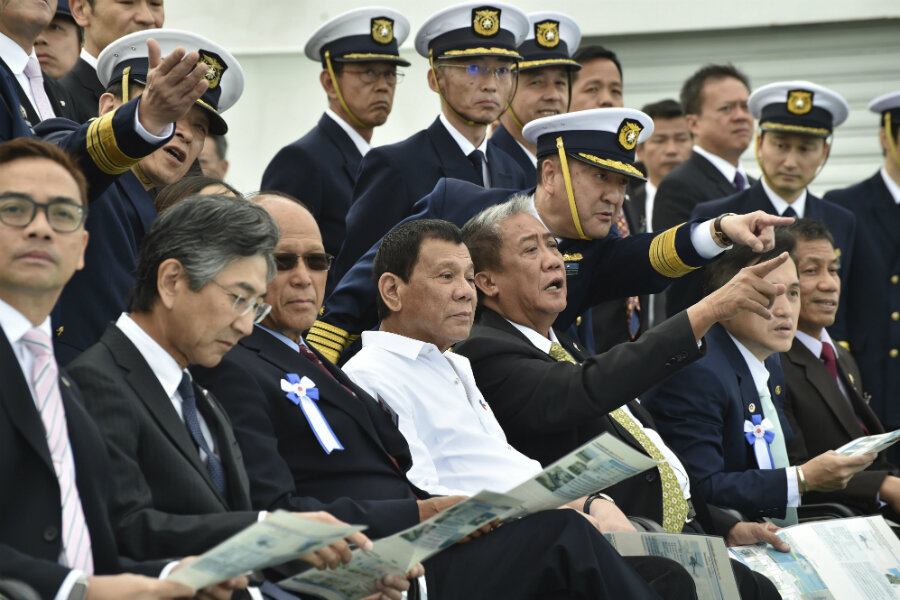Duterte's Asia tour rattles an already tense region
Loading...
| Beijing
The Philippines hosts about 100 US Army special operation troops on the southern island of Mindanao to help with counterterrorism efforts. An additional 6,400 US troops have participated in two joint military exercises in the Southeast Asian nation since April.
But if President Rodrigo Duterte gets his way, they’ll all be gone in two years.
"I want them out," he told a group of Japanese and Filipino businessmen in Tokyo on Wednesday. He also reaffirmed his pledge to not participate in future joint military exercises with the United States. The most recent war games took place earlier in October. “This will be the last maneuver, war games, between the US and the Philippine military.”
The outspoken president didn’t stop there. He said he was willing to “revise or abrogate agreements,” presumably those signed with the United States, a longtime treaty ally.
Analysts say Duterte’s aggressive push to distance the Philippines from the US has injected new uncertainties into a region already brimming with tension. China has been increasingly assertive in recent years in its claims of sovereignty over most of the South China Sea, constructing military facilities and artificial islands in the area. That has angered many of its neighbors, including Vietnam, Malaysia, and, until now, the Philippines. The US has also intensified its pushback, conducting four "freedom of navigation" patrols over the past year to challenge China's claims – most recently on Oct. 21.
But for now, amid the confusion over Duterte's true intent as he woos China, other major powers in the Pacific are being forced to wait cautiously – and avoid exacerbating tensions by overreacting to the abrupt change in tone from the Philippines' tough-talking new president.
“He is a hard bargainer in trying to reposition the Philippines in the South China Sea,” says Zhu Feng, executive director of the Center for Collaborative Studies of the South China Sea at Nanjing University. “The problem is we have to see how far he’s willing to go. How his rhetoric will turn into real action is still a big question mark.”
In Japan, concern over whether Duterte might chew gum in front of the emperor when the two were scheduled to meet Thursday quickly gave way to deeper fears over the balance of power in the Asia-Pacific. (The meeting was later canceled because of the death of Emperor Akihito’s uncle.)
“The Japanese are no doubt worried,” says Zhang Baohui, a professor of international relations at Lingnan University in Hong Kong. “Japan, like the US, wants the Philippines to play a role in weakening Chinese legitimacy in the South China Sea, and until Duterte, it had done that very well.”
Professor Zhang says few countries care as much about the South China Sea issue as Japan. The Japanese government views the Philippines as an important counterweight to China’s growing military assertiveness in the region. Much to Tokyo’s disappointment, however, Duterte has refused to pursue what was a major victory for his country: an international tribunal’s ruling in July that said China had violated international law by interfering with the rights of Filipino fishermen around the Scarborough Shoal, which both countries claim.
For Japan, which agreed this week to supply the Philippines with two patrol ships to protect its interests in the South China Sea, the dispute is also personal. Tokyo doesn’t want any precedents set in its own territorial dispute with Beijing over a chain of islands in the East China Sea (see map here).
On Thursday, Duterte told reporters his country could hold joint military exercises with Japan while reiterating that he will not conduct them with the US.
As a staunch US ally and the Philippines’ largest trading partner, Japan is in a unique position to help Manila mend its strained relationship with Washington. But Duterte appears uninterested, and he continues to cozy up to China and pull away from the US.
His remarks Wednesday provided the clearest signal yet that he wants to renegotiate a 2014 security deal signed under his predecessor. The agreement gives the US access to five military bases in the Philippines, including one on an island about 100 miles from the disputed Spratly Islands, where China has built three military outposts. The deal’s unraveling would be a major coup for Beijing, which has long viewed it as an effort to contain China.
Duterte’s approach to foreign policy is a source of widespread confusion in the US and Japan. Officials in both countries have struggled to determine his true intentions. For now, the White House has resorted to classifying his statements as political rhetoric that have yet to be supported by any official policy shifts.
“We haven’t received any formal notification or communication from the Filipino government that they're planning to make any changes to our relationship,” White House press secretary Josh Earnest said Wednesday at a news briefing in Washington.
Following Duterte’s speech on Wednesday, Philippine Foreign Secretary Perfecto Yasay told reporters in Tokyo that Manila had no intention of severing diplomatic ties with Washington. But he explained that joint military exercises hindered its ability to foster friendly relations with Beijing.
Indeed, Duterte’s eagerness to improve relations with China has emerged as one of the few constants of his foreign policy since he took office in late June. Prior to his trip to Japan, he signed some $24 billion in investment and cooperation deals during a four-day state visit to Beijing last week.
“I want to be friends to China,” Duterte said Wednesday.
The question for Japan, the US, and other countries in the region is how much that friendship will cost, and, more important, how much Duterte is willing to pay.







